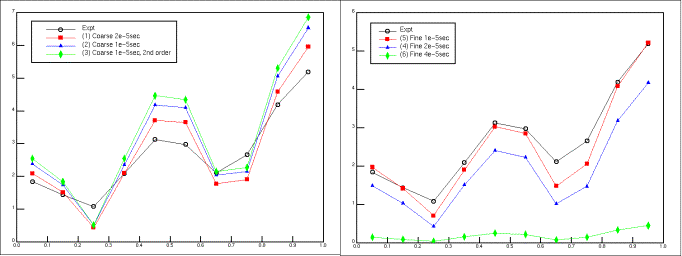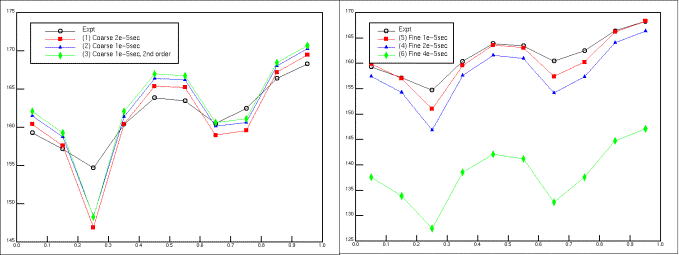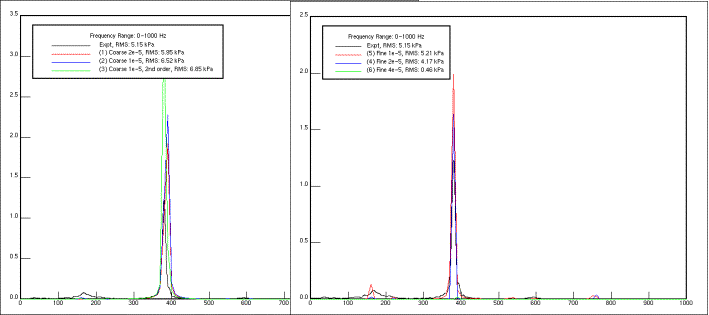Evaluation AC1-01: Difference between revisions
No edit summary |
m (Dave.Ellacott moved page Silver:Evaluation AC1-01 to Evaluation AC1-01 over redirect) |
||
| (10 intermediate revisions by 3 users not shown) | |||
| Line 1: | Line 1: | ||
{{AC|front=AC 1-01|description=Description_AC1-01|testdata=Test Data_AC1-01|cfdsimulations=CFD Simulations_AC1-01|evaluation=Evaluation_AC1-01|qualityreview=Quality Review_AC1-01|bestpractice=Best Practice Advice_AC1-01|relatedUFRs=Related UFRs_AC1-01}} | |||
='''Aero-acoustic cavity'''= | ='''Aero-acoustic cavity'''= | ||
| Line 11: | Line 13: | ||
[[Image:image011.gif]] | [[Image:image011.gif]] | ||
Figure 5: Prms along the cavity floor – coarse mesh (left) and fine mesh (right) | |||
[[Image:image014.gif]] | |||
Figure 6: Sound Pressure Level (SPL) along cavity floor – coarse (left) and fine mesh (right) | |||
Fourier analysis of the CFD pressure signals for all measurement points indicate that the predictions correctly capture four acoustic tones, three of which are broad band and a dominant narrow band mode. The power spectral density plots are typified by Figure 7 below for node 10. | Fourier analysis of the CFD pressure signals for all measurement points indicate that the predictions correctly capture four acoustic tones, three of which are broad band and a dominant narrow band mode. The power spectral density plots are typified by Figure 7 below for node 10. | ||
| Line 46: | Line 39: | ||
- Optimization of grid and time-step settings. | - Optimization of grid and time-step settings. | ||
[[Image:image017.gif]] | |||
Figure 7: PSD vs. frequency for node 10 – coarse mesh (left) and fine mesh (right) | |||
© copyright ERCOFTAC 2004 | |||
---- | |||
Contributors: Fred Mendonca; Richard Allen - Computational Dynamics Ltd | Contributors: Fred Mendonca; Richard Allen - Computational Dynamics Ltd | ||
Site Design and Implementation: Atkins and UniS | Site Design and Implementation: [[Atkins]] and [[UniS]] | ||
{{AC|front=AC 1-01|description=Description_AC1-01|testdata=Test Data_AC1-01|cfdsimulations=CFD Simulations_AC1-01|evaluation=Evaluation_AC1-01|qualityreview=Quality Review_AC1-01|bestpractice=Best Practice Advice_AC1-01|relatedUFRs=Related UFRs_AC1-01}} | |||
Latest revision as of 14:41, 11 February 2017
Aero-acoustic cavity
Application Challenge 1-01 © copyright ERCOFTAC 2004
Comparison of Test data and CFD
Time step sizes have been varied between 4.e-5 and 1.e-5 seconds. For the coarse and fine meshes, the CFD results and comparisons with experiment are presented below in the form of Prms (Figure 5) and sound pressure level, dB (Figure 6) plotted at the 10 measurement points along the cavity floor.
Figure 5: Prms along the cavity floor – coarse mesh (left) and fine mesh (right)
Figure 6: Sound Pressure Level (SPL) along cavity floor – coarse (left) and fine mesh (right)
Fourier analysis of the CFD pressure signals for all measurement points indicate that the predictions correctly capture four acoustic tones, three of which are broad band and a dominant narrow band mode. The power spectral density plots are typified by Figure 7 below for node 10.
Future work will concentrate on the following areas
- 3D calculations (assessment of run times and accuracy in anticipation of )
- Assessment of alternative turbulence models
- Optimization of grid and time-step settings.
Figure 7: PSD vs. frequency for node 10 – coarse mesh (left) and fine mesh (right)
© copyright ERCOFTAC 2004
Contributors: Fred Mendonca; Richard Allen - Computational Dynamics Ltd
Site Design and Implementation: Atkins and UniS


